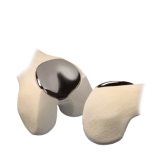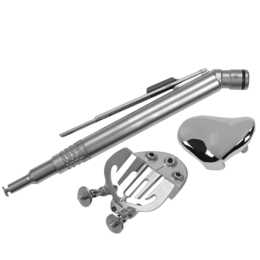Product Description
The Zimmer® Gender Solutions® Patello-Femoral Joint (PFJ) System is designed to provide an early intervention option for patients with unresolved patello-femoral pain. The Gender Solutions PFJ incorporates science based design features and offers a precise surgical technique through the use of a reproducible milling system.
Anatomic Restoration
Zimmer was the first orthopedic company to recognize that when it comes to knees, men and women are different. TheGender Solutions PFJ System addresses the unmet clinical need for patello-femoral implants that more accurately address the differences between the shapes of male and female femurs.
Modified Anterior Flange
- A thinner anterior flange is designed to help avoid overstuffing and overhang.
Increased Trochlear Groove Angle
- An increased trochlear groove angle accommodates the documented difference in the Q-angle of the patellar tracks of male and female knees.
Comprehensive Sizing
- The Zimmer Gender Solutions PFJ includes five left/right specific trochlear components. Gender Solutions female design characteristics are applied to smaller sizes (1-4), while the larger size implant is designed to match standardNexGen® Knee.
Reproducibility
Freehand instrumentation has long been the downfall of patello-femoral arthroplasty. The proprietary milling system of theGender Solutions PFJ offers an unprecedented advancement in the preparation of the distal femoral trochlea, providing a reproducible surgical technique.
- Eliminates the need for freehand preparation
- Provides accurate cartilage and bone preparation, delivering smooth patella transitions and correct depth, contour, and implant fit
- Ensures that the system may be easily converted to a Zimmer Total Knee, if necessary in the future
Versatility
The Gender Solutions PFJ System may be used in combination with the Zimmer® Unicompartmental High Flex Knee as an early intervention option for patients with bi-compartmental arthritis.
- Patello-femoral and unicompartmental components provide 35 different sizing combinations to accommodate varying patient anatomies
- Independently oriented components allow for precise alignment and rotation without compromise
Indications
- Osteoarthritis, traumatic arthritis, polyarthritis, and/or severe chondrocalcinosis of the patello-femoral joint
- The salvage of previously failed surgical attempts (e.g., arthroscopy, lateral release, cartilage transplantation)
- History of patellar dislocation or patellar fracture
- Dysplasia-induced degeneration
Contraindications
- Previous history of infection in the affected joint and/or local/systemic infection that may affect the prosthetic joint
- Insufficient bone stock
- Insufficient menisci and/or ligament structures
- Skeletal immaturity
- Neuropathic arthropathy
- Severe instability, maltracking, malalignment of the patella, patello-femoral and/or tibio-femoral joints







